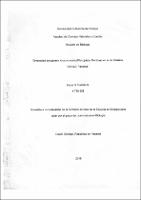Diversidad del género Anacroneuria (Plecoptera: Perlidae) en el río Caldera, Chriquí, Panamá.
Abstract
Uno de los grupos más primitivos de la clase Insecto es el orden Plecoptera,
también conocidos como "moscas de piedra". Con el objetivo de contribuir al
conocimiento taxonómico y ecológico del género Ánacroneuria, se realizaron
muestreos en siete estaciones en el río Caldera durante el 2015. Cada estación
fue muestreada una vez al mes, durante una a dos horas recolectando
organismos de rocas y hojarasca sumergida mediante una red triangular y en
forma manual, para su posterior crianza en sistemas de acuarios en el
laboratorio (MUPADI). Se recolectaron 485 ninfas de las cuales 138 llegaron a
su etapa adulta (g=83 y d=55) identificadas en cinco especies
Anacroneuria annulipalpis, A. marca, 4. quetzali (entre 1,147 m s.n.m. y los
1,882 m s.n.m.), Á. benedettoi, A. planicollis (entre 360 m s.n.m. y
1,065 m s.n.m.) y dos especies aún por identificar. Se amplía el ámbito de
Distribución de ,4. benedettoi para la provincia de Carriquí y se reporta por
Primera vez a .4. quetzalli para Panamá. Se realizan claves para adultos y ninfas
Del género, Anacroneuria para este río y la asociación de las ninfas .A planicollis
Á. quetzalli, y ,Anacroneuria sp.l con su adulto. La cría de ninfas en el laboratorio
es el método más simple, de bajo costo y fácil mantenimiento, siempre que sea
manipulado rigurosa y correctamente. Las múltiples intervenciones
antropogénicas que se están realizando sobre los sistemas fluviales de nuestro
país, pueden provocar la desaparición de estas especies, sin que lleguen a ser
conocidas. Por ello, se plantea la urgente necesidad de su estudio en aquellos
sistemas fluviales donde aún se carece de información de estos organismos. One of the most primitive groups of the Insects class is the order Plecoptera,
also known as "stoneflies." in order to contribute to the taxonomic and ecological
knowledge of the genus 4r7acroneuda, samples were carried out at seven
stations on the Caldera River during 2015. Each station was sampled once a
month for one to two hours by collecting rock organisms and submerged leaf
litter a triangular network and in manual form, for later breeding in aquarium
systems in the laboratory (MUPADI). We collected 485 nymphs of which 138
reached adulthood (g = 83 and d ' = 55) identified Hive species
Anacroneuia annulipalpis , ,4. marco, .4. quetzalli (between 1,147 m s.m. and
1,882 m s.n.m), .4. Benedottoi, ,4. planicollis (between 360 m s.n.m. and
1,065 m s.n.m.) and two species yet to be identified. Keys are made for adults
and nymphs of the genus .4nacroneuda for this river and the association of
nymphs .A. planicollis .A. quetzalli, and , anacroneuria sp. 7 with its adult. Raising
nymphs in the laboratory is the simplest, inexpensive and easy to maintain
method, provided it is handled rigorously and correctly. The multiple.
anthropogenic interventions that are being carried out on the fluvial systems of
our country, can cause the disappearance of these species, without they become
known. Therefore, the urgent need for their study in river systems where there is
stilla lack of information of these organisms.
Collections
Related items
Showing items related by title, author, creator and subject.
-
First report of Pleurodema brachyops (Anura: Leptodactylidae) for Pacific islands (Seville Island, Chiriqui, Panama): Primer reporte de Pleurodema brachyops (Anura: Leptodactylidae) para las Islas del Pácifico (Isla Sevilla, Chiriquí, Panamá)
Romero, Angel; Quiroz, Michelle; González-Pinzón, Macario; Castillo-Vega, Patricia; Benítez-Montoya, C. ElizaEn Panamá Pleurodema brachyopsse distribuye en las provincias de Darién, Panamá, Panamá Oeste, Coclé, Herrera, Veraguas y Chiriquí. Proporcionamos registros de la nueva distribución localizada en Isla Sevilla (Chiriquí), ... -
Notas sobre la anidación del Búho Listado (Asio clamator) en el Cerro San Cristóbal, Chiriquí, Panamá: Notes on the nesting of the barred owl (Asio clamator) on Cerro San Cristóbal, Chiriquí, Panamá
Ponce, Marcos; González, EdgarEl búho listado (Asio clamator), se encuentra ampliamente distribuido en el neotrópico, esta especiese puede encontrar en distintos hábitats, este trabajo ofrece información sobre la anidación,comportamiento defensivo del ... -
Diagnóstico de la calidad del servicio postal de Correos Panamá en Chiriquí: desafíos y oportunidades: Assessment of the quality of the Panama Post Office's postal service in Chiriquí: challenges and opportunities
Justavino Castillo , Milva Eileen; Beitia Araúz, Kristy LorenCorreos Panamá, una de las instituciones más antiguas del país, fue durante muchos años un referente en las comunicaciones tanto para ciudadanos como para empresas. Sin embargo, el paso del tiempo y el avance de la tecnología ...

